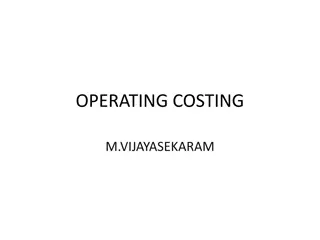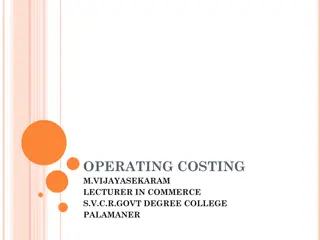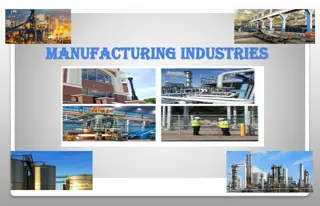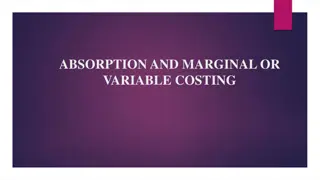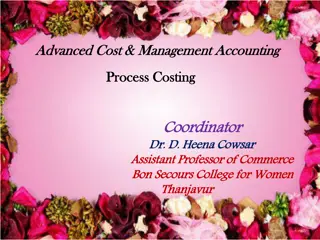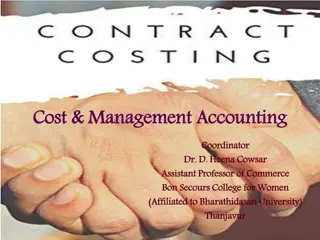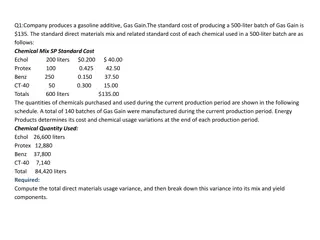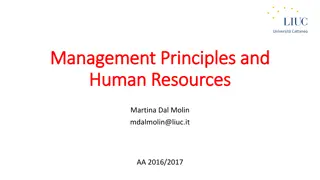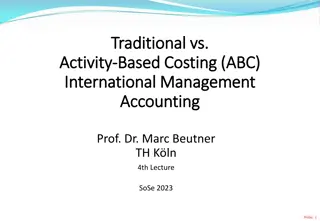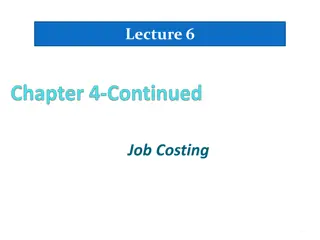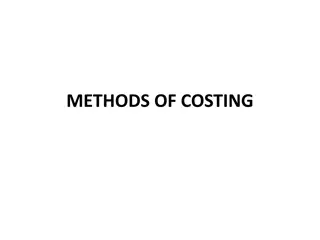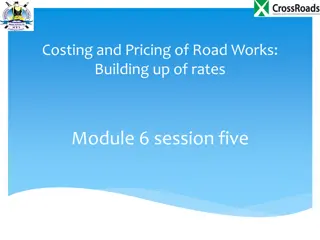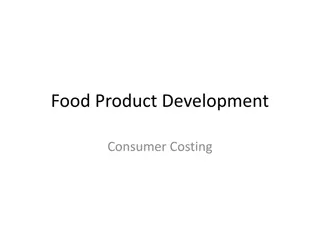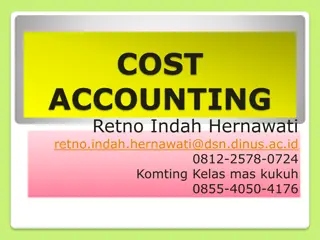Understanding Process Costing in Manufacturing Industries
Process costing is a widely used method in mass production industries like steel and chemicals. It involves accumulating costs process-wise for standardized products resulting from sequential operations. Essential characteristics include continuous production, standardized products, and handling normal loss. The costing procedure involves maintaining separate accounts for each process, accounting for normal loss, abnormal gain, and output transfers. Normal loss is an unavoidable part of the process.
Download Presentation

Please find below an Image/Link to download the presentation.
The content on the website is provided AS IS for your information and personal use only. It may not be sold, licensed, or shared on other websites without obtaining consent from the author. Download presentation by click this link. If you encounter any issues during the download, it is possible that the publisher has removed the file from their server.
E N D
Presentation Transcript
PROCESS COSTING Chapter 8
Topics Introduction ESSENTIAL CHARACTERISTICS OF PROCESS COSTING PROCESS COSTING AND JOB COSTING A COMPARISON Costing Procedure Normal Loss and abnormal loss Normal Gain and abnormal Gain WHEN OUTPUT OF IS PARTLY SOLD AND PARTLY TRANSFERRED TO THE NEXT PROCESS WORK-IN-PROGRESS (EQUIVALENT PRODUCTION ) (INTER-PROCESS PROFITS)
PROCESS COSTING PROCESS COSTING Process costing is probably the most widely used method of cost ascertainment. It is used in mass production industries producing standard products, like steel, sugar and chemicals.
ESSENTIAL CHARACTERISTICS OF PROCESS COSTING ESSENTIAL CHARACTERISTICS OF PROCESS COSTING 1. The production is continuous and the final product is the result of a sequence of processes. 2. Costs are accumulated process-wise. 3. The products are standardized and homogeneous. 4. The cost per unit produced is the average cost which is calculated by dividing the total process cost by the number of units produced. 5. The finished product of each but last process becomes the raw material for the next process in sequence and that of the last process is transferred to the finished goods stock. 6. The sequence of operations or processes is specific and predetermined. 7. Some loss of materials in processes (due to chemical action, evaporation, etc.) is unavoidable. 8. Processing of a raw materials may give rise to the production of several products. These several products produced from the same raw material may be termed as joint products or by-products.
Costing Procedure The factory works are divided into different processes and a separate account is maintained for each process. (Debit the following items) (Credit the Following Items) Materials - Normal Loss and Scrap -Weight Loss (Only units & No amount) Wages - Sale of By Product Direct Expenses - Sale of Out put Production Overheads - Value of abnormal loss Abnormal Gain - Cost of output transferred to next process Prepared By- Prof. Jitendra Patoliya
Normal Loss It is a part of the process loss which is caused under normal circumstances, and an inevitable loss.(i.e. loss due to evaporation/ shrinkage) It can not be avoided by any steps or measures by the management. It is also referred to as a non-controllable loss. Normal loss may have a scrap value. The cost of normal loss after deducting scrap value, if any, is to be borne by the output of the respective process. It is calculated as percentage of inputs with the help scientific study Prepared By- Prof. Jitendra Patoliya
Abnormal Loss It is a part of the process loss which is caused due to abnormal circumstances. (i.e. Loss due to labor strike, Breakdown of machinary, Power failure, Accident etc.) Abnormal loss is avoidable and controllable by the management by establishing proper precautionary measures. Abnormal loss occurs in addition to normal loss. it is calculated by following formula (Units) (Input-Normal loss=Expected output) (Expected output-Actual out put =Abnormal Loss) Rate of Abnormal Loss= OR Prepared By- Prof. Jitendra Patoliya
Abnormal Gain Abnormal gain arises when the actual wastage (loss) is less than the normal wastage or when the actual output is more than the normal output. Abnormal gain arises due to rise in the efficiency of the production department, so the benefit of abnormal gain will not be transferred to customers. Formula for Abnormal gain Units of A.G=Actual output- Expected output=Inputs Inputs-Normal loss= Abnormal gain Rate of A.G= OR Prepared By- Prof. Jitendra Patoliya
Particular Units Rate per Unit Amount = No. of Units* Rate per unit Normal Loss % of input (Given in Problem) Scrap value per unit (Given in Problem) Abnormal Loss Actual output < Expected output (Input-Normal loss=Expected output) (Expected output-Actual out put =Abnormal Loss) Abnormal Gain Actual output > Expected output Actual output- Expected output=Inputs Inputs-Normal loss= Abnormal gain Weight loss (Given in Problem) Zero
WHEN OUTPUT OF IS PARTLY SOLD AND WHEN OUTPUT OF IS PARTLY SOLD AND PARTLY TRANSFERRED TO THE NEXT PARTLY TRANSFERRED TO THE NEXT PROCESS PROCESS Sometimes the output of a process may be partly sold and partly transferred to the next process for further processing. For example, in a textile mill, part of the output of a spinning process may be sold and the remaining output is passed on to the weaving process for further processing. A part of the output so sold will contain an element of profit or loss which will be revealed in the Process Account. But when a part of the output is sent to warehouse for sale, it is at cost and does not contain an element of profit or loss.
WORK WORK- -IN (EQUIVALENT PRODUCTION ) (EQUIVALENT PRODUCTION ) IN- -PROGRESS PROGRESS Process costing mainly deals with continuous type of production. At the end of the accounting period, there may be some work-in-progress, i.e., semi-finished goods may be in the pipeline. The valuation of such work-in-progress is done in terms of equivalent or effective production. Equivalent Production Equivalent production represents the production of a process in terms of completed units. Work-in-progress at the end of an accounting period are converted into equivalent completed units.
EVALUATION OF EQUIVALENT EVALUATION OF EQUIVALENT PRODUCTION PRODUCTION Ascertain the cost per unit of equivalent production separately for each element of cost. This is done by dividing the total cost of each element by the respective number of equivalent units. Find out the total cost (net) for each element of cost, i.e., material, labour and overheads. Scrap value of normal loss is deducted from the material cost. At this rate of cost per unit, ascertain the value of finished production and work-in- progress. For the purpose of computation of equivalent production and its evaluation, the following three statements are generally prepared: (a) Statement of equivalent production (b) Statement of cost (per unit) (c) Statement of evaluation These three statements may also be combined in one comprehensive statement called Statement of Production, Cost and Evaluation.
EQUIVALENT PRODUCTION EQUIVALENT PRODUCTION When there is no opening stock and with process loss Normal Loss-Equivalent units of normal loss are taken as nil. In other words, normal loss is not added in the equivalent production. However, realizable value of normal scrap is deducted from the cost of material so as to calculate the net material cost. This net material cost becomes the basis of calculating the material cost per unit in the statement of cost. Abnormal Loss-This is treated as if this were good production lost. Abnormal loss, thus, is added to equivalent production with due consideration to its degree of completion. Unless the degree of completion is specified, it may be assumed that abnormal loss units are 100% complete in respect of all elements of cost. Abnormal Gain-Units of abnormal gain are represented by good finished production. It is therefore, always taken as 100% complete in respect of all elements of cost, i.e., material, labour and overheads. Abnormal gain is deducted to obtain equivalent production.
EQUIVALENT PRODUCTION(CONTD.) EQUIVALENT PRODUCTION(CONTD.) When there is opening as well as closing stock of work-in-progress In such a case there are two methods of calculating equivalent production: 1. FIFO: This method is based on the assumption that work-in-progress moves on a first-in-first out basis. This means that unfinished work on the opening stock is completed first, before work on any new units is taken up. Computation of Equivalent Production under FIFO Method. State the opening stock of work-in-progress in equivalent completed units. This is done by applying the percentage of work needed to complete the unfinished work of the previous period. 1 Ascertain the number of units introduced into the process and deduct the number of units of closing work-in-progress. This gives the number of units started and completed during the period. Add these units to the opening stock of work-in-progress calculated in (i) above. 2 Add to the above the equivalent completed unit of closing work-in-progress. This can be determined by applying the percentage of work done on the finished units at the end of the period. 3
EQUIVALENT PRODUCTION(CONTD.) EQUIVALENT PRODUCTION(CONTD.) 2. Average Cost Method In this method, the cost of opening work-in-progress is not kept separately but is averaged with the additional costs incurred during the period. This method thus combines the cost of opening work-in-progress and new production. Information relating to degree of completion of opening WIP is not required. In order to find out the cost per unit of equivalent production, the cost of each element (material, labour and overheads) applicable to the opening work-in-progress is added to the cost incurred in the current period for that element. A single cumulative total and unit cost is obtained. Units completed and transferred as well as closing work- in-progress will be valued at this average unit cost.
HOW TO CHOOSE BETWEEN FIFO HOW TO CHOOSE BETWEEN FIFO AND AVERAGE METHOD AND AVERAGE METHOD Use Average - If the cost of opening work-in-progress is given in terms of materials, labour and overhead but the stage of completion is not given. Use FIFO - If the cost of the opening work-in-progress in one lump sum figure and the stage of completion is given. FIFO or Average-Your Choice - If the degree of completion and the cost in terms of materials, labour and overheads of the opening work- in-progress are given, then one has a choice between FIFO and Average methods. Where the question specifies a method to be followed, then that method must be followed.
INTERNAL PROCESS PROFITS (INTER INTERNAL PROCESS PROFITS (INTER- - PROCESS PROFITS) PROCESS PROFITS) In some businesses, it is a practice to charge the output of each process to the next process not at cost but at a price showing profit to the transferor process. The transfer price may be either the current market price or cost plus a fixed percentage. In brief, the objects of such internal process profit are: (c) To assist in making decisions, such as to buy a partly-processed material rather than to process work internally or to sell a partly-processed product or to process it further. (a) To show whether the cost in each process competes with the market prices. (b) To make each process stand on its own efficiency and economy.
Categories of numerical Category Example No. Page No. Normal (Normal loss, Weight loss, Abnormal loss, Abnormal gain) 1,2,3,6,9 8.62, 8.63 & 8.64 Inter-process profit 32 8.71 Equivalent units 22,30 8.70








